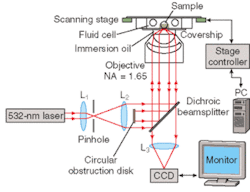Researchers at the Swinburne University of Technology (Victoria, Australia) have developed a new way of implementing optical trapping that does not require high power, generate a lot of heat, or significantly restrict access to the sample. In addition, the technique can be implemented using a simple modification of existing instruments. Researchers say the reduced trapping volume—particularly in the z direction—should make optical trapping more suitable for the manipulation of single micro- and nanoparticles. Also, it has been shown that the technique can be used to lift objects against gravity: in a recent experiment, researchers have calculated that, with 10 µW of optical power, they can lift a polystyrene particle up to 800 nm in diameter.
Optical trapping is caused by steep gradients in the electric field as light is focused using lenses with large numerical apertures (NAs). When using conventional far-field techniques, however, the shape of the focus is elongated in the direction of the optical axis, with an axial (z) trapping distance about three times greater than the transverse (x and y) trapping distances. This makes it more difficult to pick up a single particle in a solution containing many, because two or more can become trapped simultaneously.
Evanescent waves, created at the low-index side of an interface where total internal reflection is taking place, don't have this disadvantage. This is because, by their nature, they decay rapidly with the distance from the interface. The problem is that, ordinarily, the totally internally reflecting beam is too weak to perform any kind of useful trapping. Other researchers have tried to use metallic tips to enhance the field but, so far, these techniques have had the disadvantage in that the same surface plasmons that perform the amplification also produce a heating effect that reduces trapping stability. Another potential technique, using an evanescent field near a nano-aperture, has proven difficult to implement in practice.
Obstruction blocks light
The Swinburne University researchers have avoided these problems by combining the conventional near- and far-field techniques in a simple way.1 As with the usual far-field technique, theirs uses a focused laser beam. As in most common near-field techniques, researchers use total internal reflection only to produce the evanescent wave. The difference is that they filter the beam to be focused in advance, so that only light that will totally internally reflect is allowed to pass through the focusing objective. Researchers achieve this by simply putting an obstruction—an opaque disk—in the path of the beam. The obstruction blocks the light from the center that would arrive at the interface at small angles from the optical axis.
Not only does this technique exploit the shallowness of the evanescent field, it also reduces the size of the trap in the transverse direction. Because of the size and symmetry of the obstruction, diffraction occurs, and the rays constructively interfere where they converge at the center of the focus. This has the dual advantage of enhancing and narrowing the evanescent field. The researchers have implemented the new technique using an inverted scanning total-internal-reflection microscope, and have used the instrument to demonstrate particle trapping, moving and lifting, and to verify theory (see figure).
Led by Min Gu, director of the university's Center for Micro-Photonics, the Swinburne team has also recently carried out a series of experiments to determine whether a so-called doughnut beam can be used in the setup. The TEM01 mode (in which the field is concentrated in a ring around the center of the focus) had previously been used with optical traps to good effect, as it allows trapping with reduced power on the specimen being manipulated, reducing the potential for damage. It has also been used to rotate objects and as a means of performing torque measurements on a small scale.
Though researchers have yet to demonstrate that all the benefits of using the TEM01 mode can be retained, recent results (yet to be published) show that they can be used for trapping in their system. Theory and experiment confirm that axial- and transverse-trapping efficiencies are almost identical for plane and doughnut beams. Researchers also found that, for the highest trapping efficiency, the beam should not be focused exactly at the media interface, but 100 nm below it.
REFERENCE
- Min Gu et al., Appl. Phys. Lett. 84, 21 (May 24, 2004).
About the Author
Sunny Bains
Contributing Editor
Sunny Bains is a contributing editor for Laser Focus World and a technical journalist based in London, England.
